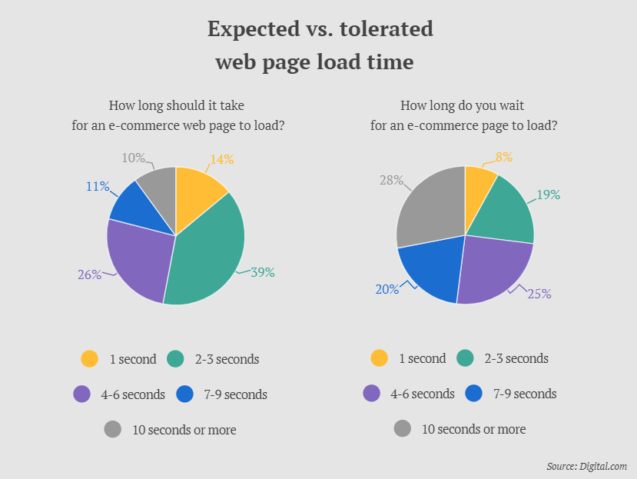A few things are as important in your marketing, PR, and headhunting as your company’s website. Your website can attract customers, partners, and employees; and just as easily it can scare them off in a couple of seconds. But how do you know when it’s time to update or redesign your website? Will users just one day stop using it altogether? Or will there be a steady decline in traffic until you notice that something has gone horribly wrong and after a long consideration go for an expensive website audit?
-
Your website is slow
You’d be surprised to know how terribly impatient Internet users are. Or maybe you won’t be since you’re one of them! According to most recent research, one in two visitors abandon a website that takes more than six seconds to load. 19% of respondents say they will abandon a web page that takes longer than 2-3 seconds to load, while 8% will leave after only one second. 25% of online shoppers will abandon a page that doesn’t load within 4-6 seconds.
If this seems dramatic, keep in mind that the situation is even harder when it comes to mobile site visitors. More than half (53%) of mobile site visitors will leave a page if it takes longer than three seconds to load.
This obviously affects user experience and website conversion. This also negatively impacts search engine rankings.
You can use Google’s PageSpeed Insights or alternative tools to evaluate your website’s speed and then perform the necessary updates.
-
Your website is not responsive
It’s 2022, and if you still don’t have a mobile/phone responsive interface (i.e. one that automatically adjusts for different-sized screens and viewports), quit whatever you’re doing right now and redesign your website. According to the latest reports, almost 60% of all web traffic comes through mobile phones. It’s a known factor in Google’s rankings, and it’s crucial for user experience and website conversion. And as it happens, Google provides a straightforward and universal tool to test your website for its mobile-friendliness called Mobile-Friendly Test. You just enter a page URL to see how your page scores, and decide quickly on redesign if the answer is not that great.
-
Your website is difficult to navigate
Have you ever felt that your website just isn’t very logical? Then, it’s time for an update! Your users should clearly see at every point in time where they are, where they were before that, and where they need to go next to achieve their website goals. Every problem the user faces along the way leads to confusion and frustration, which in turn leads to them abandoning the website, avoiding the link and not purchasing your product or service. They also won’t be coming back, and your high bounce rates and lower traffic will decrease your search engine rankings. It’s all downhill from there! If that’s the case, time to ask your in-house designers or software design companies how to make a website that is easy for anyone to navigate.
-
Your website looks outdated
This might be a simple one, but you might just not be paying attention to it. Yet, your website is often the first thing your client or future employee finds out about your company. It’s the face of it, and it matters. If it doesn’t look clean, professional, and up-to-date, the next step in your relationship, whether it’s a customer journey or anything else might just not happen. If the colors are terrible, the images are poorly fitted, and the content placement is random, people won’t think about your company, your product, and your service well either.
-
Your competitors have newer websites
Sometimes, you need to look at your competitors and think no further. Doubting whether you need a redesign? Check what your competitors are doing with their sites. Remember, yours will be compared to theirs when the user will inevitably do their research. Being up-to-date on your own competitor research will give you a clear understanding of when to update or redesign your own website.
-
Your website is inconsistent
Inconsistency across website pages is a common problem. Companies often change their branding, positioning, and marketing materials over time, and some things get mixed up, lost and forgotten on the website. If that’s the case with your website, time for a redesign. Consistency is a must in website design. Consistent branding keeps the visitor’s attention, helps them remember the brand, and nudges the user towards the goal, whether it’s a click, a share, or a purchase. It also makes the company look professional and trustworthy.
-
Your website is more than 5 years old
There’s no set-in-stone rule about how often you need to update your website. But five years works as a rule of thumb. In five years Google has made enough updates to make your way of doing things irrelevant, design trends have definitely moved forward, and new technologies have changed the way your website should be operating.
-
Your website needs new functionality or new content
If your business is successful enough, it will grow, and your website will grow with it. With time, you’ll need to add new features, new blog posts, new integrations, and plenty of small elements to your website. Your structure and design should make these tasks easy. If this isn’t the case, time to think about a major change. It’s better to do one now than to suffer with small changes for years to come.
What to do once you decide you need a redesign?
So you’ve found that your website indeed fits this checklist. Great, now you can start with the job! You can work with your in-house team of designers or outsource to a company that offers UX and UI design services. Whatever you do, you need to plan the redesign. Planning includes:
-
Benchmarking current metrics
After the redesign, you’ll need to know what changed, so make sure that you know the top-performing assets on your website.
-
Defining your goals
So much can change with the website redesign, but what should you focus on the most? Of course, the outcomes! These can be:
- New leads and conversions
- Better rankings
- Higher traffic
- Better on-site metrics
- All of the above!
-
Branding and tone of voice
Make sure your branding and tone of voice are made more clear and not lost during your redesign.
-
SEO
Protecting your rankings is important during the redesign ― you don’t want to lose the place you’ve earned on Google or other search engines. This is done by ensuring all SEO best practices are followed during the new website build.
So, are you ready to improve your website? Talk to our team, and we’ll tell you how we can help!










